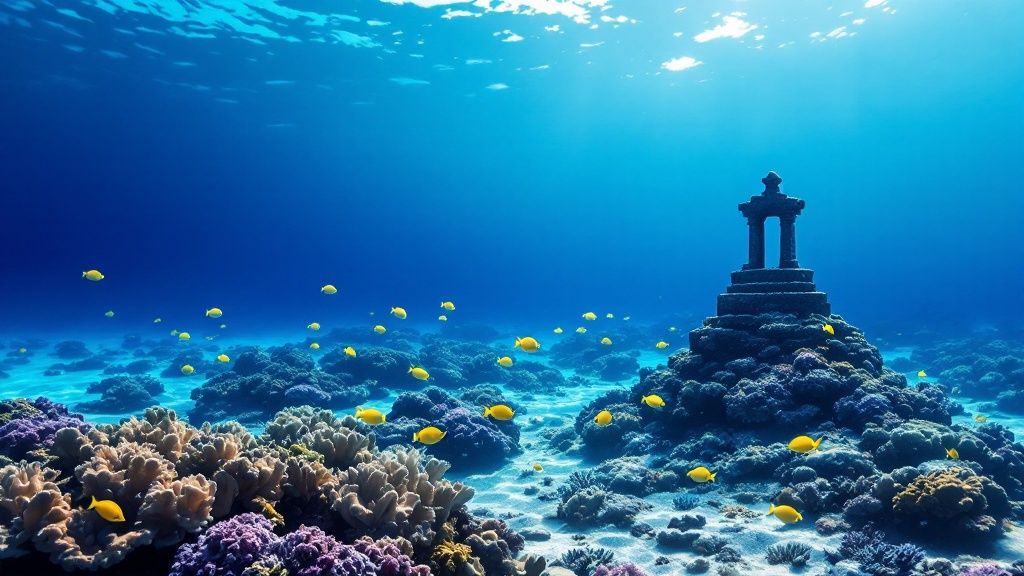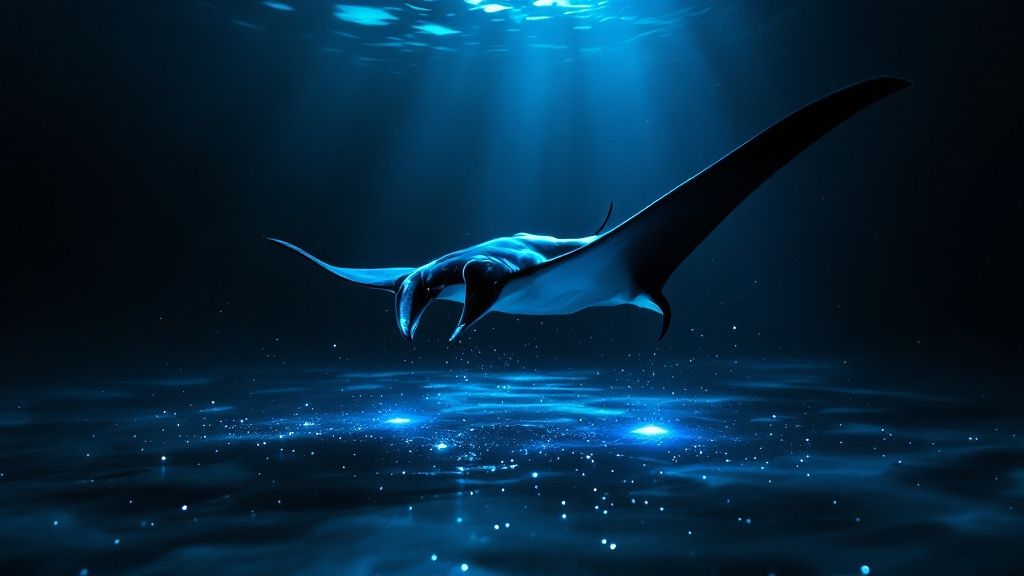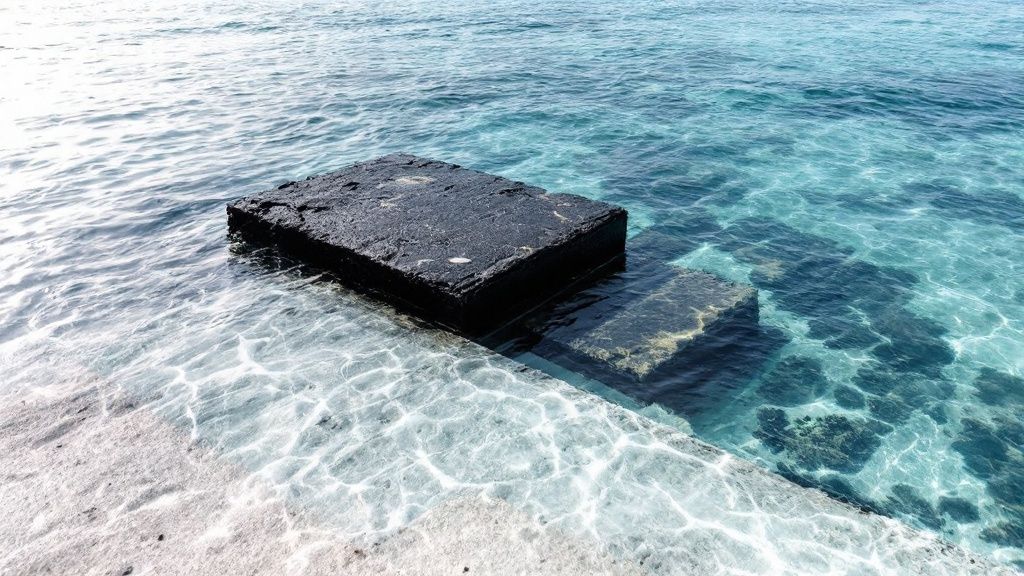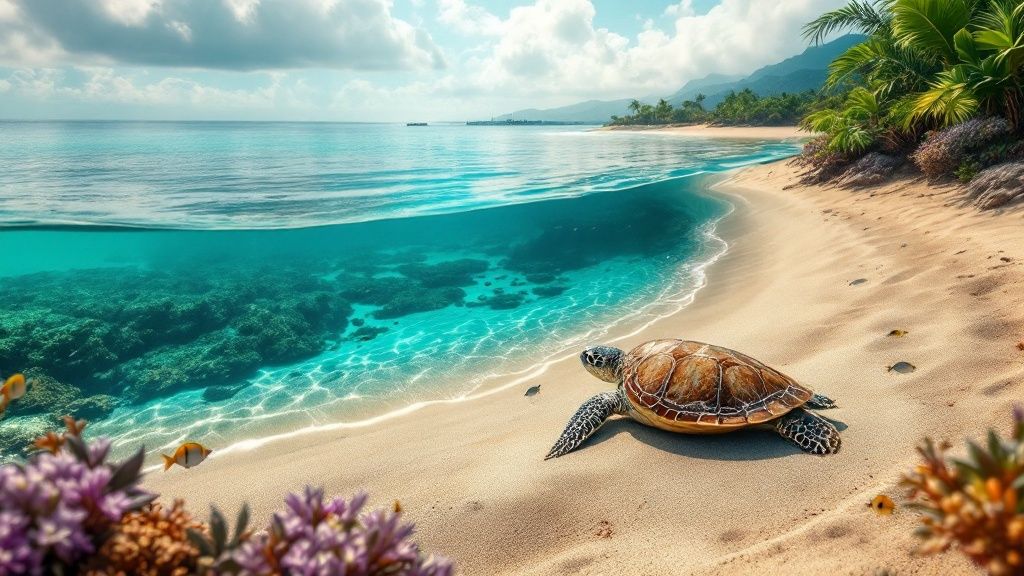Dive into Paradise: Exploring the Big Island's Underwater Wonders
Discover six exceptional Big Island scuba diving locations. This list highlights top spots for unique underwater experiences, whether you're a beginner or seasoned diver seeking thrilling marine encounters. From vibrant reefs to mesmerizing manta rays, find the perfect Big Island dive site for your next adventure. Learn about each location's distinct features and prepare to explore the best of Hawaii's underwater world.
1. Kealakekua Bay: A Must-Dive for Big Island Scuba Diving
Kealakekua Bay, nestled on the western coast of the Big Island, is a jewel in Hawaii's crown of dive sites. This pristine marine sanctuary offers an unparalleled big island scuba diving experience, boasting vibrant coral reefs, exceptional visibility often exceeding 100 feet, and a rich history as the site of Captain James Cook's first landing and subsequent demise. The bay's protected status ensures a thriving ecosystem teeming with over 100 species of fish, making it an ideal destination for divers of all skill levels, from beginners taking their first breaths underwater to seasoned explorers seeking new depths.

Kealakekua Bay’s diverse underwater landscape caters to a variety of diving styles. The average depth ranges from 25-40 feet, perfect for leisurely exploration and introductory dives, while deeper sections offer challenges for more experienced divers. The remarkable water clarity provides breathtaking views of the vibrant coral gardens and the abundant marine life that calls them home. Kealakekua Bay is a popular spot for snorkeling and diving, and is home to the Captain Cook Monument. For a guided snorkeling experience in this area, check out this Captain Cook snorkel tour. The bay’s historical significance adds another layer of intrigue to the diving experience, with the Captain Cook Monument standing as a reminder of the area’s past.
Features:
- Spectacular coral reef ecosystem
- Historical significance with Captain Cook Monument
- Protected marine conservation district
- Average depth of 25-40 feet, with deeper options available
- Water visibility often exceeding 100 feet
Pros:
- Exceptional marine biodiversity, including over 100 species of fish
- Relatively calm waters throughout the year
- Accessible for various skill levels from beginner to advanced
- Boat access provides better coverage of the entire bay
- Limited shore access helps preserve the reef system
Cons:
- Often crowded, especially during peak tourist seasons
- Shore entry requires a challenging hike or kayak journey
- Boat tours can be expensive
- Limited parking for those attempting shore access
- Special permits required for certain activities
Examples of Dive Operators:
- Fair Wind Cruises offers popular scuba and snorkel tours to the bay.
- Kona Diving Company provides guided dives highlighting historical and ecological features.
Tips for Diving in Kealakekua Bay:
- Visit early morning for best visibility and fewer crowds.
- Book boat trips in advance, especially during peak season.
- Bring an underwater camera to capture the vibrant reef life.
- Look for spinner dolphins that frequently visit the bay.
- Consider multi-tank dives to explore different sections of the reef.
Learn more about Kealakekua Bay for information on snorkeling tours and other activities in the area. Whether you’re a seasoned diver seeking an unforgettable big island scuba diving adventure or a beginner eager to explore the wonders of the underwater world, Kealakekua Bay offers an experience unlike any other.
2. Manta Ray Night Dive
The Manta Ray Night Dive off the Kona Coast is a truly unique big island scuba diving experience, renowned worldwide. Divers kneel or sit on the ocean floor in relatively shallow water (30-40 feet) with specialized dive lights pointed upwards. These lights attract plankton, the manta ray's primary food source, creating a mesmerizing spectacle as the graceful giants, with wingspans reaching up to 16 feet, perform acrobatic barrel rolls to feed just inches above the divers' heads. This magical encounter allows for an unparalleled and close-up observation of these gentle giants in their natural environment.

This dive deserves its place on this list because it offers a reliable and accessible way to witness one of the ocean's most captivating creatures. Two primary locations, Manta Village (near Kona Airport) and Manta Heaven (Garden Eel Cove), offer consistent manta ray sightings year-round. The relatively shallow depth makes it suitable for divers of all certification levels, from beginners to advanced. Even non-divers can partake in the magic with complementary snorkeling options available.
Features and Benefits:
- Unique opportunity to observe feeding manta rays at night
- Consistent manta ray sightings year-round
- Two convenient locations: Manta Village and Manta Heaven
- Relatively shallow dive depth (30-40 feet)
- Snorkeling option available for non-divers
- Educational component about manta conservation
Pros:
- One of the most reliable places worldwide to see mantas predictably
- Accessible to all certification levels
- Environmentally responsible approach to viewing marine life
- Truly a once-in-a-lifetime experience
Cons:
- Night diving can be intimidating for beginners
- Water can get cold after extended stationary periods
- Can be crowded due to popularity
- Success depends on natural wildlife behavior (though sightings are common)
- More expensive than standard dive excursions
Examples of Dive Operators:
- Big Island Divers offers specialized manta night dive packages.
- Jack's Diving Locker pioneered many of the sustainable practices used in these dives.
- Kona Honu Divers combines the experience with manta ray conservation education.
Tips for an Unforgettable Experience:
- Bring a good wetsuit to stay warm in the cooler water.
- Practice buoyancy control before the trip to remain still on the bottom without disturbing the reef.
- Avoid using hands to stabilize yourself to prevent reef damage.
- Never touch the mantas – maintain the recommended 15-foot distance unless they approach you.
- Book in advance as these dives frequently sell out.
- Consider booking a snorkel and dive combo if traveling with non-divers.
When and Why to Choose this Dive:
This dive is ideal for anyone fascinated by manta rays and looking for a truly memorable big island scuba diving experience. It's perfect for those seeking a unique night dive, families with mixed diving and snorkeling abilities, and underwater photographers hoping to capture stunning images. The consistent sightings make it a worthwhile investment, even for those with limited time on the Big Island.
The Manta Ray Night Dive was popularized through Jacques Cousteau documentaries featuring Kona's mantas, National Geographic features, the Manta Pacific Research Foundation, and the local dive operators who developed the responsible viewing protocols in the 1990s. It remains a must-do activity for any scuba diver visiting the Big Island.
3. Black Water Night Diving
Black Water Night Diving is arguably one of the most unique and thrilling ways to experience big island scuba diving. This advanced diving experience takes you far offshore into the deep ocean, typically over depths exceeding 3,000 feet. Divers are suspended in the open water at night, tethered to a downline from the boat, creating a truly otherworldly feeling. This specialized setup allows you to witness the mesmerizing vertical migration of rare pelagic creatures and deep-sea organisms that ascend towards the surface after dark. Many of these fascinating creatures are rarely seen and can't be observed anywhere else without using specialized deep-sea submersibles.

While you're floating over extreme depths, the actual dive depth for black water diving is typically between 40 and 60 feet. This makes it accessible to suitably qualified divers, despite the deep ocean environment below. This truly frontier diving experience offers intimate encounters with marine life unlike any other type of big island scuba diving. Operators like Big Island Divers offer "Pelagic Magic" experiences, while Kona Honu Divers provide dedicated Black Water Diving excursions. You can even find specialized photography expeditions led by underwater photographers catering to those looking to capture images of these rarely seen creatures. Learn more about Black Water Night Diving
This type of dive deserves a place on this list because it offers a truly unique perspective on the marine life surrounding the Big Island. It's an opportunity to witness a hidden world and contribute to our understanding of these deep-sea inhabitants.
Features and Benefits:
- Open ocean dive suspended over incredibly deep water.
- Encounters with rare deep-sea creatures during their nightly vertical migrations.
- Specialized dive setup with tethers and powerful lights.
- Small group experiences with high guide-to-diver ratios for personalized attention.
- Uncrowded and unique big island scuba diving adventure.
Pros:
- Opportunity to see extremely rare and unusual marine life.
- Unparalleled photographic opportunities.
- Contributing to citizen science through documentation of new species.
- Personalized attention from highly experienced guides.
Cons:
- Requires advanced diving certification and excellent buoyancy control.
- Higher cost than standard dives.
- Can be disorienting due to the lack of a bottom reference.
- Potential for seasickness in open ocean conditions.
- Higher cancellation rates due to weather dependency.
- Not suitable for inexperienced or anxious divers.
Tips for Black Water Diving:
- Bring a high-quality primary dive light and a reliable backup.
- Configure your camera settings for black water photography beforehand.
- Consider taking anti-seasickness medication if you're prone to motion sickness.
- Practice and refine your buoyancy control before attempting this dive.
- Pay close attention to the pre-dive briefing, especially regarding tether protocols.
- Book multiple nights if possible, as each black water dive experience is unique and can vary dramatically.
The popularity of black water diving has grown significantly thanks to the stunning images captured by underwater photographers like Jeff Milisen, scientific papers documenting vertical migration patterns, National Geographic features on deep-sea creatures, and the widespread sharing of extraordinary creature encounters on social media.
4. Two Step (Honaunau Bay)
Two Step in Honaunau Bay is a must-do for any big island scuba diving adventure. This exceptional shore dive site, conveniently located next to Pu'uhonua O Hōnaunau National Historical Park (Place of Refuge), earns its name from the unique lava rock formation that provides an easy, two-step entry into the clear, protected waters. Just yards from the shore, a vibrant coral garden teeming with marine life awaits, making it ideal for both snorkelers and scuba divers. This site seamlessly blends cultural significance with an unforgettable underwater experience, as the bay historically served as a sanctuary for Hawaiians who broke kapu (sacred laws).

Two Step's easy accessibility is a major draw. The natural lava "steps" provide a convenient entry and exit, minimizing the equipment haul often associated with shore diving. This makes it an excellent choice for beginners and families, while experienced divers will appreciate the extensive shallow reef system and depths reaching 40+ feet. The protected bay typically offers calm conditions, creating an ideal environment for underwater exploration. Moreover, its proximity to the Place of Refuge adds a layer of cultural depth to the experience, allowing you to combine big island scuba diving with historical exploration. Learn more about Two Step (Honaunau Bay)
Features:
- Easy shore entry via natural lava "steps"
- Extensive shallow coral reef system
- Protected bay with typically calm conditions
- Adjacent to important Hawaiian cultural site
- Depths ranging from surface to 40+ feet
- Coral gardens beginning just offshore
Pros:
- No boat required – excellent shore diving with minimal equipment haul
- Suitable for snorkelers and divers of all experience levels
- Free access (though park entrance fee applies if using main lot)
- Can be dived at your own pace without time restrictions
- Combines cultural exploration with diving in one location
- Good alternative when boat dives are canceled due to weather
Cons:
- Limited parking that fills early, especially on weekends
- Can be crowded during peak hours
- Entry requires some agility on slippery lava rock
- Facilities are minimal with only basic restrooms
- Surface swim required to reach deeper sections
Examples & Tips:
- Local dive shops like Kona Boys offer guided shore dives at Two Step, highlighting its popularity as a premier dive location.
- Many certification courses utilize this site for training dives due to its easy access and diverse marine life. It is frequently featured in Hawaii shore diving guidebooks as a must-visit location.
- Arrive early (before 8am) to secure a parking spot, especially on weekends.
- Wear protective footwear until you reach the entry point to navigate the lava rock safely.
- Keep an eye out for the resident pod of spinner dolphins often spotted in deeper water.
- Be respectful of the cultural significance of the adjacent historical park.
- Explore the 'Eel Condo' area, a known habitat for numerous moray eels.
- Visit on weekdays to avoid the larger weekend crowds.
Two Step deserves its place on this list because it truly offers something for everyone. From beginners taking their first breaths underwater to seasoned divers seeking a convenient and rewarding shore dive, the site caters to a wide range of experience levels. Its calm, protected waters, abundant marine life, and cultural significance create a unique and unforgettable big island scuba diving experience.
5. Crescent Beach (Honokōhau Harbor)
Crescent Beach, nestled just north of Kailua-Kona near Honokōhau Harbor, is a prime location for big island scuba diving, particularly appealing for its easy shore access and abundant marine life. This crescent-shaped haven offers a unique blend of beginner-friendly conditions and captivating underwater encounters, making it a must-consider spot for divers of all skill levels. The gradually sloping sandy bottom transitions seamlessly into vibrant coral structures, offering a diverse underwater landscape perfect for exploration. This spot earns its place on our list due to its reliable turtle sightings, convenient location, and diverse dive environment suitable for both day and night diving.
One of the highlights of Crescent Beach is undoubtedly the resident turtle cleaning stations. Here, Hawaiian green sea turtles (honu) congregate to have parasites removed by smaller fish, providing divers with an incredible opportunity to observe these gentle giants up close. This site also offers moderate depths ranging from 10-50 feet, making it suitable for beginners while still offering enough depth to intrigue more experienced divers. The protected harbor area generally provides calm conditions, further enhancing the ease and enjoyment of the dive. Learn more about Crescent Beach (Honokōhau Harbor)
Features:
- Easy shore entry from sandy beach
- Turtle cleaning stations with rich marine life interactions
- Moderate depths (10-50 feet)
- Mix of sandy bottom and coral formations
- Protected harbor area with typically calm conditions
- Accessible facilities and parking at nearby harbor
Pros:
- High probability of turtle encounters
- Beginner-friendly entry and exit
- Convenient location near Kona with good facilities
- Can be combined with boat dives departing from the adjacent harbor
- Excellent night diving location showcasing different marine life
Cons:
- Less dramatic coral formations compared to other Big Island sites
- Occasional boat traffic due to harbor proximity
- Potential for reduced visibility after heavy rains
- Limited shade at the entry point
- Some gear hauling required from parking area to entry point
Examples of Crescent Beach Diving Experiences:
- Kona Diving Company offers guided shore dives focusing on turtle behavior and interactions.
- Night dives reveal sleeping turtles tucked under ledges and a different array of nocturnal marine life.
- The site's popularity extends to underwater photography workshops, often concentrating on capturing stunning turtle photography.
Tips for an Optimal Dive at Crescent Beach:
- Visit during mid-day for peak turtle activity at the cleaning stations.
- Maintain a respectful distance from resting turtles (minimum 10 feet).
- Explore the nooks and crannies – look for octopus hiding amongst the rocks and coral.
- Bring a mesh bag to collect any trash you might encounter, contributing to the preservation of this beautiful site.
- Utilize the harbor facilities before and after your dive for added convenience.
- Explore both north and south from the entry point to discover different underwater environments.
Crescent Beach offers a remarkable big island scuba diving experience, balancing ease of access with captivating marine encounters. Whether you’re a beginner eager to explore the underwater world or a seasoned diver seeking a relaxing yet rewarding dive, Crescent Beach deserves a spot on your Big Island diving itinerary.
6. Pine Trees (Kohanaiki Beach Park)
Pine Trees at Kohanaiki Beach Park offers a distinctive big island scuba diving experience, setting it apart from the typical resort dives. This site, named for the ironwood trees lining the shore (often mistaken for pines), presents a captivating underwater world sculpted by ancient lava flows. Located north of Kailua-Kona, it provides a unique blend of reef and rocky habitats teeming with marine life, making it an excellent choice for various skill levels, from novice to advanced divers comfortable with shore entries.
The underwater topography is the star attraction here. Lava tubes, swim-throughs, and dramatic arches create an adventurous playground for exploration. Depth ranges from a shallow 10 feet to over 60 feet, catering to different comfort levels. Whether you're a beginner exploring the vibrant reef or a seasoned diver venturing into the deeper lava formations, Pine Trees has something to offer. This diversity sets it apart from many other big island scuba diving sites, which often focus on either shallow reefs or deep walls.
The varied environment also supports a rich array of marine life, providing ample opportunities for underwater photography. Macro enthusiasts will find plenty of nudibranchs and small critters hiding amongst the rocky surfaces, while wide-angle photographers can capture the stunning lava formations and schooling fish.
Pros:
- Diverse Underwater Topography: Explore lava tubes, arches, and swim-throughs unlike any other site.
- Less Crowded: Escape the hustle of popular tourist spots and enjoy a more tranquil dive.
- Cavern and Swim-through Exploration: Perfect for adventurous divers seeking unique underwater experiences.
- Free Access and Parking: Enjoy the dive without entrance fees and convenient parking at the public beach park.
- Photography Opportunities: Capture stunning images of both macro life and larger landscape features.
Cons:
- Challenging Entry: Navigation over rocks can be tricky, especially during higher surf.
- Requires Shore Diving Experience: Some familiarity with shore diving techniques is recommended.
- Longer Surface Swim: Be prepared for a surface swim to reach the main underwater features.
- Potential Strong Currents: Certain areas can experience strong currents.
- Limited Shade and Facilities: The public beach park offers basic facilities but limited shade.
Examples of Successful Implementation:
- Local dive clubs frequently choose Pine Trees for group dives due to its unique topography and accessibility.
- Advanced shore diving courses utilize this site to teach entry/exit techniques in more challenging conditions.
- Underwater photographers flock here to capture the unique lava formations and diverse marine life.
Tips for Diving Pine Trees:
- Enter during high tide for an easier navigation over the rocks.
- Bring reef shoes to protect your feet during entry and exit.
- Use a surface marker buoy to alert boat traffic to your presence.
- Always check conditions before diving, as the site is exposed to ocean swells.
- Explore lava tubes and overhead environments only if properly trained and equipped.
- Look closely at the rocky surfaces for nudibranchs and other small critters.
Learn more about Pine Trees (Kohanaiki Beach Park) for additional information and tips to enhance your diving experience.
Pine Trees deserves a place on any big island scuba diving itinerary for its unique underwater landscape, diverse marine life, and accessibility as a shore dive. While it presents some challenges, the rewards are well worth the effort for those prepared for a slightly more adventurous experience. This site is ideal for adventurous scuba divers, those looking to shore dive, underwater photographers seeking dramatic landscapes, and anyone who appreciates a less crowded and more natural diving environment.
Top 6 Big Island Dive Spots Comparison
| Dive Spot / Tip | 🔄 Implementation Complexity | 💡 Resource Requirements | 📊 Expected Outcomes | ⚡ Ideal Use Cases | ⭐ Key Advantages |
|---|---|---|---|---|---|
| Kealakekua Bay | Moderate – boat or challenging shore entry | Boat rental or kayak, permits | High biodiversity, exceptional visibility | All skill levels; scenic coral reefs | Pristine marine sanctuary; calm waters; rich history |
| Manta Ray Night Dive | Moderate – night dive, stationary on bottom | Good wetsuit, buoyancy skills, dive gear | Unique manta ray encounters | Night diving enthusiasts, photo ops | Reliable manta sightings; educational conservation focus |
| Black Water Night Diving | High – advanced skills, tethered open ocean | Specialized lights, tether setup, advanced certification | Rare deep-sea creature sightings | Experienced divers seeking rare pelagic life | Frontier diving; low crowds; citizen science contribution |
| Two Step (Honaunau Bay) | Low – easy shore entry | Minimal gear, protective footwear | Accessible coral gardens and cultural exploration | Shore divers, beginners, locals | Easy access; cultural site adjacency; free entry (park fee applies) |
| Crescent Beach (Honokōhau) | Low – simple shore entry | Basic gear, parking at harbor | Frequent turtle encounters; calm water | Beginners, turtle watchers | Easy access; turtle cleaning stations; good facilities |
| Pine Trees (Kohanaiki) | Moderate – rocky shore entry, variable surf | Reef shoes, surface marker buoy | Diverse underwater topography, macro and landscape photography | Experienced shore divers; photographers | Unique lava tubes and arches; less crowded; free access |
Ready to Explore? Plan Your Big Island Diving Adventure
From the vibrant coral reefs of Kealakekua Bay teeming with colorful fish to the mesmerizing manta ray night dives and the truly unique black water diving experience, Big Island scuba diving offers an unmatched variety of underwater adventures. Whether you're an experienced diver seeking thrilling new depths or a beginner eager to explore Hawaii's breathtaking marine life, this island paradise has something for everyone. Remember the unique experiences waiting for you at sites like Two Step in Honaunau Bay, Crescent Beach at Honokōhau Harbor, and the accessible Pine Trees site at Kohanaiki Beach Park – each offering a distinct glimpse into the underwater world. Mastering buoyancy control and proper diving techniques will not only enhance your safety but also allow you to fully appreciate the delicate beauty and biodiversity of these incredible ecosystems. Exploring the underwater world of the Big Island is more than just a dive; it's a journey into a realm of wonder and discovery that will leave you with memories to last a lifetime.
Ready to experience the magic of Big Island scuba diving? Kona Honu Divers, a locally owned and operated dive company, provides expert-led excursions to all the top dive sites mentioned, ensuring a safe and unforgettable experience. Visit Kona Honu Divers to book your next dive adventure and explore the underwater wonders of Hawaii.
